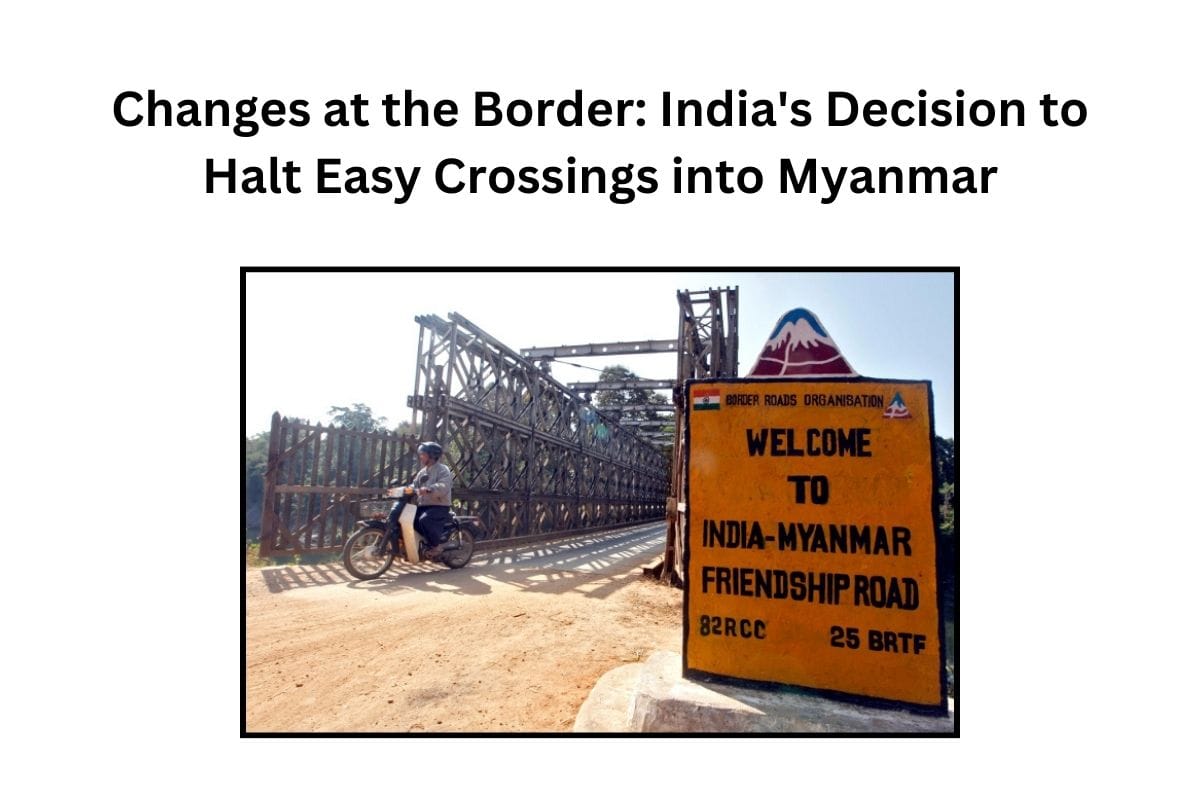
As a part of the latest current affairs that took place, the Indian government has announced the termination of the Free Movement Regime (FMR), which allowed people living along the India-Myanmar border to cross 16 kilometers without the need for visas. This decision aims to address security concerns by sealing the porous frontier with advanced fencing.
Key Points
- India’s decision to end the Free Movement Regime (FMR) along the India-Myanmar border.
- Previously allowed visa-free 16-kilometer entry for people living on both sides of the border.
- FMR initiated in 2018 to promote cultural ties between tribes residing along the border.
- Allowed individuals to travel up to 16 km without visas based on annual border passes.
- Misuse of FMR by insurgent groups for staging attacks and escaping arrest.
- Porous border facilitating unchecked immigration, narcotics, and gold smuggling.
Understanding the FMR:
The Free Movement Regime (FMR), initiated in 2018, was intended to foster cultural ties between tribes living on both sides of the India-Myanmar border. Under this arrangement, individuals could travel up to 16 kilometers without the requirement for visas, promoting community exchange.
Issues Leading to the Decision:
However, the relaxed regulations of the FMR were exploited by insurgent groups, enabling them to carry out attacks and evade arrest by crossing the border. Additionally, the porous nature of the border facilitated unchecked immigration and illegal activities, including narcotics and gold smuggling.
Demands for Closure and Security Measures:
Last September, Manipur’s Chief Minister expressed concerns about unauthorized entries, urging an end to the FMR. To address these concerns, the entire 1,600 km India-Myanmar border, spanning four Indian states, will now undergo comprehensive sealing over the next 4.5 years. Advanced surveillance systems will be implemented to enhance border security and prevent unregulated movement.
Balancing Security and Interests:
The decision to terminate the FMR reflects the government’s assessment that security threats outweigh the benefits of unrestricted movement, even in the context of friendly bilateral ties. While this move marks a departure from the long-standing tradition of community exchanges, it aligns with India’s broader strategic goals in the region. The emphasis is on rational border management and the development of necessary infrastructure.
Geopolitical History Of India And Myanmar
The geopolitical history between India and Myanmar is characterized by a complex interplay of strategic, economic, and cultural factors. Here are key aspects of their relationship:
Historical Ties:
India and Myanmar share deep historical and cultural connections dating back centuries. Both nations have been linked through trade routes and cultural exchanges, fostering mutual influences in art, religion, and traditions.
Colonial Legacy:
During the British colonial era, both India and Myanmar were under British rule. The geographical proximity and shared history of resistance against colonial powers laid the foundation for a sense of solidarity and understanding.
Post-Independence Relations:
After gaining independence, India and Myanmar established diplomatic ties in 1948. The initial years were marked by cooperation, with both countries being part of the Non-Aligned Movement (NAM) during the Cold War.
Strategic Importance:
The strategic significance of the India-Myanmar relationship gained prominence during the 1950s and 1960s. Myanmar served as a buffer state between India and China during times of heightened Sino-Indian tensions.
Border Issues:
Despite historical ties, the India-Myanmar border has witnessed occasional disputes, primarily due to issues related to demarcation and illegal cross-border activities. Both countries have engaged in dialogues to address these concerns and enhance border management.
Economic Cooperation:
Economic ties between India and Myanmar have strengthened over the years. Cross-border trade, energy cooperation, and infrastructure development projects have contributed to economic integration and mutual development.
Security Cooperation:
Security cooperation has been a crucial aspect of the bilateral relationship. Both nations have collaborated on counter-insurgency efforts along the border, addressing concerns related to insurgent groups operating in the region.
Regional Connectivity:
The India-Myanmar-Thailand Trilateral Highway and the Kaladan Multi-Modal Transit Transport Project are examples of collaborative efforts to enhance regional connectivity. These projects aim to boost trade and people-to-people exchanges.
Challenges and Opportunities:
The geopolitical dynamics between India and Myanmar also face challenges, including issues related to Rohingya refugees, cross-border insurgency, and managing China’s influence in the region. Balancing these challenges with opportunities for collaboration remains a key aspect of their relationship.
Current Dynamics:
In recent years, both nations have focused on strengthening economic ties, people-to-people exchanges, and addressing common challenges such as terrorism and climate change. Regular high-level visits and diplomatic engagements underline the commitment to maintaining a multifaceted and mutually beneficial relationship.
Conclusion
As India takes steps to secure its border with Myanmar, the decision highlights the delicate balance between fostering regional relationships and addressing security challenges. The implementation of advanced technologies and border management strategies will play a crucial role in achieving both security objectives and broader geopolitical interests in the region.
Important Questions For Exams
- Explain the background and initiation of the Free Movement Regime (FMR) between India and Myanmar.
- Analyze the historical significance of the India-Myanmar border and its impact on cultural ties.
- Discuss the security challenges that led to the decision to terminate the FMR.
- Evaluate the potential misuse of the FMR provisions by insurgent groups and its implications for border security.
- Examine the potential impact of sealing the India-Myanmar border on regional dynamics.
- Discuss how this decision may influence geopolitical relations between India and Myanmar.
- Compare and contrast India’s approach to border management with Myanmar with that of other neighboring countries.
- Analyze the differences in strategies employed by India and Myanmar to address border security concerns.


